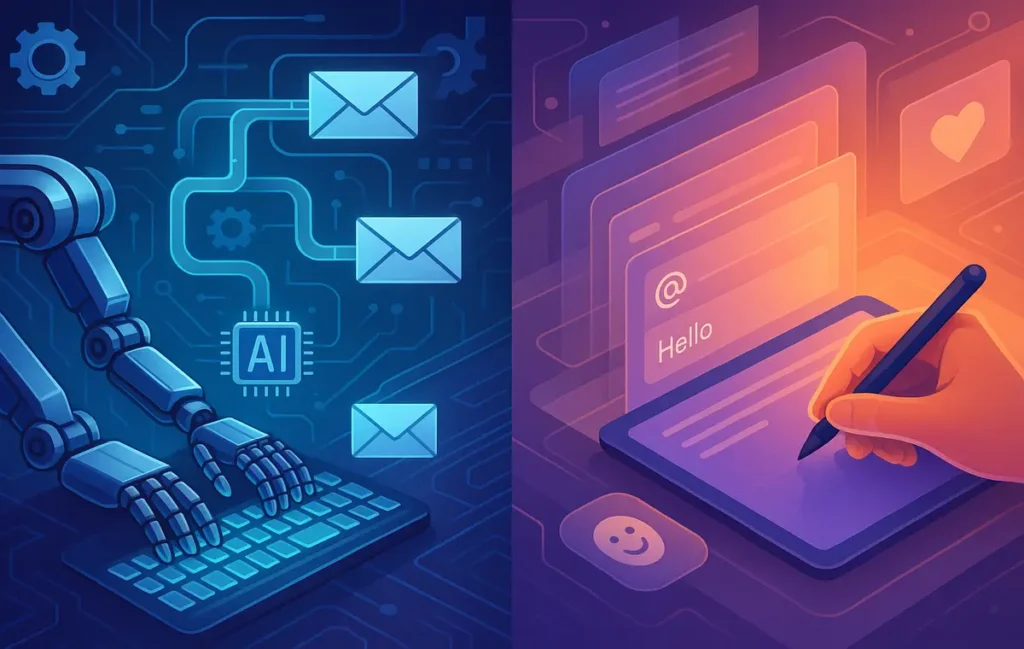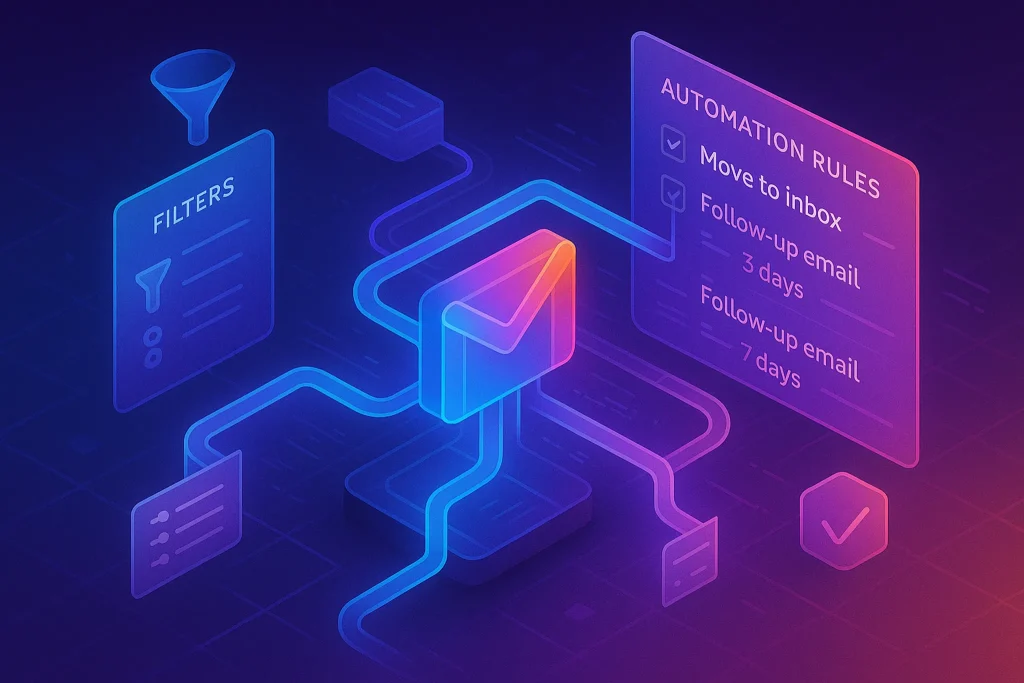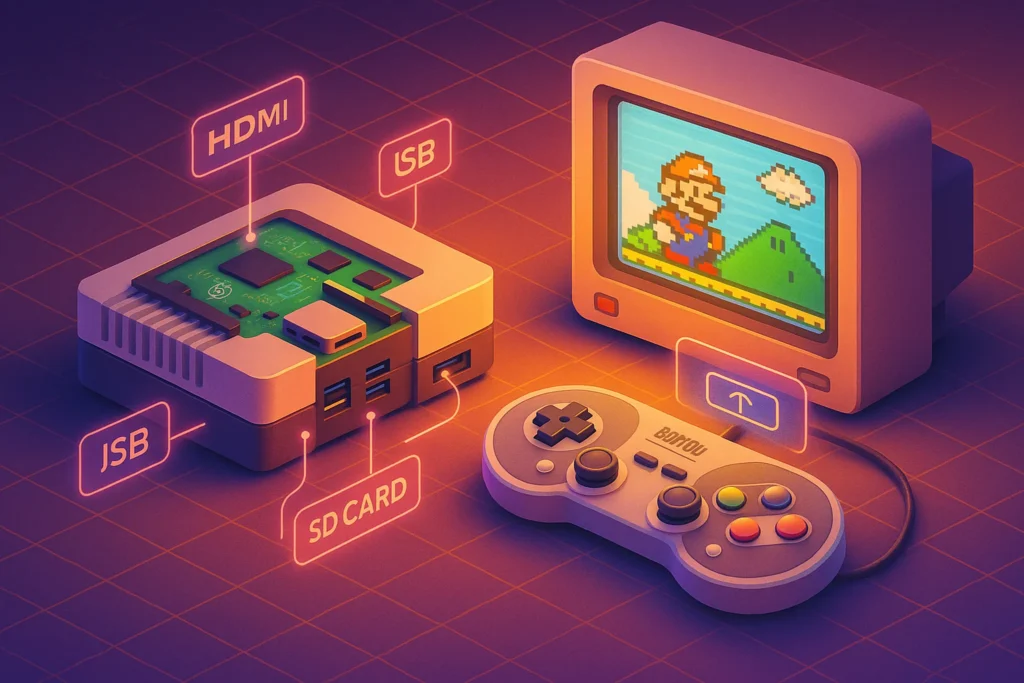🎯 Intro
There’s nothing worse than opening a nurture email that feels like it was written by a lifeless robot. The subject line is generic, the copy is bland, and the sender’s name might as well be “no-reply.” You know it’s part of a sequence, and you instantly disengage.
This is the danger many startups and small businesses face when they turn to automation. In the rush to save time and scale outreach, the human spark is often lost. And yet, lead nurturing is where trust is either built or broken. The challenge isn’t just how to automate—it’s how to automate without losing authenticity.
🔍 Why Lead Nurturing Matters
Lead nurturing is the process of building relationships with prospects at every stage of their journey. It’s about more than sending emails—it’s about guiding potential customers from awareness to decision with valuable, relevant, and timely communication.
For startups and SMBs, this is non-negotiable. Research consistently shows that nurtured leads make larger purchases and convert at higher rates. In fact, businesses that excel at nurturing generate 50% more sales-ready leads at a 33% lower cost compared to those that don’t.
But nurturing is not just about closing deals. It’s also about building brand equity. When a prospect feels like a company understands their needs and speaks in a voice that feels human, they’re far more likely to stay engaged long term. On platforms like NerdChips, we’ve seen how authenticity-driven nurturing feeds into broader strategies like building an AI-powered email list or integrating lightweight CRMs for micro-businesses.
💡 Nerd Tip: Nurturing is not about volume—it’s about resonance. A single authentic email can outperform five automated but generic ones.
⚡ The Risk of Losing Authenticity
Automation is powerful, but overuse can backfire. When every touchpoint is automated, your messages risk sounding repetitive, transactional, and disconnected. Prospects quickly sense when they’re being “processed” rather than cared for.
The impact is serious: engagement rates drop, unsubscribe rates climb, and worst of all, trust erodes. Authenticity is the antidote. A brand that maintains a human tone and occasionally surprises leads with manual check-ins stands out. Authenticity means your audience feels like there’s a real person on the other side of the inbox.
This is where businesses must draw a clear line between automating repetitive tasks and outsourcing human connection. Automation should free you to invest more energy in personal moments, not replace them entirely. That distinction sets apart effective nurturing flows from glorified spam campaigns.
🛠️ Framework: Automate Without Losing the Human Touch
A balanced framework begins with segmentation. Not every lead belongs in the same sequence. By grouping based on behavior, intent, or stage in the buyer journey, your automation feels tailored rather than templated. Pair this with personalization tokens, but use them wisely. A first name alone isn’t enough—contextual cues like referencing a recent download or a webinar attended go much further.
Blending automation with manual touchpoints is key. For example, after three automated nurture emails, insert a personal outreach from a sales rep via LinkedIn DM. Or schedule one weekly “manual check-in” for high-value prospects flagged in your CRM.
Integrating CRM and email tools is also crucial. A lightweight CRM helps consolidate interactions so that every automated email is context-aware. Without this, you risk sending irrelevant or redundant messages. For small teams, even a combo like Gmail filters integrated with Zapier can simulate a CRM-lite approach, similar to workflows we explored in How to Automate Email Follow-Ups in Gmail Using Filters.
💡 Nerd Tip: Write every automated email as if it were going to one person only. If it feels like a mass blast, rewrite it.
📊 Tools That Help Balance Automation & Authenticity
Several platforms excel at marrying efficiency with empathy. HubSpot offers robust lead scoring and CRM integration, making it easy to automate without losing visibility into context. ActiveCampaign shines with dynamic content and conditional logic, allowing you to personalize at scale. ConvertKit is particularly useful for creators and bloggers who want automation that feels conversational. Zoho CRM is a budget-friendly option for micro-businesses that still need centralization. And for lightweight workflows, a Zapier + Gmail Filters combo can help solo founders implement smart nurturing without overbuilding.
When evaluating these tools, remember that the best system is one that complements your communication style. If your brand voice is informal and conversational, choose a tool that lets you embed that tone naturally into sequences. Pairing tools with strategies from 10 Best Email Marketing Tools or even Best Lightweight CRMs for Micro-Businesses ensures your tech stack supports—not sabotages—authentic outreach.
⚡ Set Up Authentic Automation
Try tools like ActiveCampaign or ConvertKit to launch your first nurture sequence that blends automation with personal touch. Scale smarter, not colder.
🚀 Step-by-Step Implementation
Start by mapping your buyer journey. Outline the major milestones—from first awareness to final decision—and highlight where communication matters most. Next, identify nurture touchpoints such as onboarding sequences, educational emails, or reminders to revisit abandoned carts.
Then, automate repetitive tasks like follow-ups and reminders. But instead of setting endless auto-drips, strategically add “human checkpoints.” For example, after a prospect clicks a pricing link but doesn’t convert, trigger a manual follow-up from a rep. This hybrid model ensures automation handles scale, while humans handle nuance.
Finally, monitor key engagement metrics. Open rates and click-throughs matter, but reply rates and qualitative feedback are equally important. Refine sequences continuously by testing tone, frequency, and message framing. As we discussed in Ultimate Guide to Building an Email List with AI Tools, automation works best when combined with data-driven iteration.
⚠️ Challenges & Solutions
Every lead nurturing system faces challenges. Spam filters are a constant threat, but can be mitigated with domain authentication, proper warm-up, and clean list hygiene. Audience fatigue is another issue—overloading prospects with too many emails erodes goodwill. Instead, balance frequency with value. Finally, keeping tone authentic is a creative challenge. A/B test not just subject lines, but also variations in tone: professional vs conversational, short vs detailed.
By treating nurturing as both art and science, you create a system that automates the mechanics while preserving the humanity.
🚀 Real Case Studies: Wins and Failures
Success stories often dominate marketing conversations, but failures are just as instructive. One B2B SaaS brand proudly rolled out a fully automated nurture sequence—seven emails sent over two weeks, with zero human intervention. On paper, it was efficient. In practice, unsubscribe rates spiked by 28%, and customer feedback revealed that emails felt “robotic” and “generic.” The campaign ended up damaging trust rather than building it.
Contrast this with a small e-commerce brand that took a hybrid approach. They used automation for abandoned cart reminders but layered in a manual “Did you have trouble checking out?” email from a support rep. That single human checkpoint reduced cart abandonment by 15% and increased repeat purchases. The lesson is clear: automation saves time, but human touch drives loyalty.
🧠 The Psychology of Authenticity
Why do customers instinctively trust an authentic message more than a polished but robotic one? Psychology provides the answer. Humans are wired to respond to empathy and personalization. When an email reads as if it was written for “me,” it activates trust pathways in the brain. Neuroscience research even points to mirror neurons playing a role—when we sense a human voice, our brains mirror the social connection.
Authenticity also taps into reciprocity. If a brand takes the time to sound genuine, recipients feel more inclined to respond or engage. That’s why cold automation often fails: it skips the emotional bond that turns a prospect into a relationship. This isn’t just about tone—it’s about showing care in small details like subject lines, context, and timing.
💡 Nerd Tip: Every message you send is an opportunity to reinforce or erode trust. Choose wisely.
📋 Authenticity Checklist
Here’s a quick test before you hit “send” on any automated email:
-
Would this message feel natural if sent by a real individual on your team?
-
Does the tone sound conversational, or does it scream “template”?
-
Is the email providing real value, or is it just pushing for a click?
If you can confidently answer “yes” to the first two and “no” to the last, you’re on the right track. Otherwise, refine until your automation feels indistinguishable from a personal message.
🔮 Future Outlook: AI and Hyper-Personalization
Looking toward 2026 and 2027, the landscape of lead nurturing will shift dramatically. AI will enable dynamic personalization where every email changes in real time based on user behavior. Imagine a sequence where two recipients open the same email, but the copy, visuals, and call-to-action adapt instantly based on their browsing history or last engagement.
Hyper-personalized nurture flows will feel less like marketing campaigns and more like genuine conversations. But here’s the caveat: even with advanced AI, brands that lose sight of empathy and authenticity will still struggle. Technology can personalize at scale, but it can’t replace the intentionality of a human-driven strategy. For readers of NerdChips, the future is about mastering the blend—leveraging AI tools while safeguarding the human essence.
🔗 Beyond Email: Omni-Channel Nurturing
Lead nurturing doesn’t live inside an inbox alone. Today’s most effective brands weave nurture flows across multiple channels. An educational blog post can trigger a follow-up sequence. A webinar attendance can open a pathway to tailored case studies. Even social engagement can feed into personalized nurture campaigns.
This omni-channel approach ensures leads experience consistency and depth wherever they engage. For instance, a nurture email might direct a lead to a blog article. That article then invites them to a gated guide, which loops them back into a CRM-driven workflow. By treating content marketing and nurture automation as one ecosystem, businesses create compounding touchpoints.
💡 Nerd Tip: Think of nurture as a journey, not a channel. Every piece of content—whether it’s a blog, email, or LinkedIn DM—can be a meaningful step forward.
📬 Want More Smart AI Tips Like This?
Join our free newsletter and get weekly insights on AI tools, no-code apps, and future tech—delivered straight to your inbox. No fluff. Just high-quality content for creators, founders, and future builders.
🔐 100% privacy. No noise. Just value-packed content tips from NerdChips.
🧠 Nerd Verdict
Automated lead nurturing without authenticity is just intelligent spam. Winners in the modern digital landscape are those who master both: leveraging automation for scale while preserving human touch for trust. If you can combine data-driven systems with genuine voice, you’re not just nurturing leads—you’re nurturing relationships.
❓ FAQ: Nerds Ask, We Answer
💬 Would You Bite?
Would you rather receive a single email that feels personal—even if it comes a day later—or get an instant but robotic reply that erodes trust?
Crafted by NerdChips for creators and teams who want their best ideas to travel the world.



